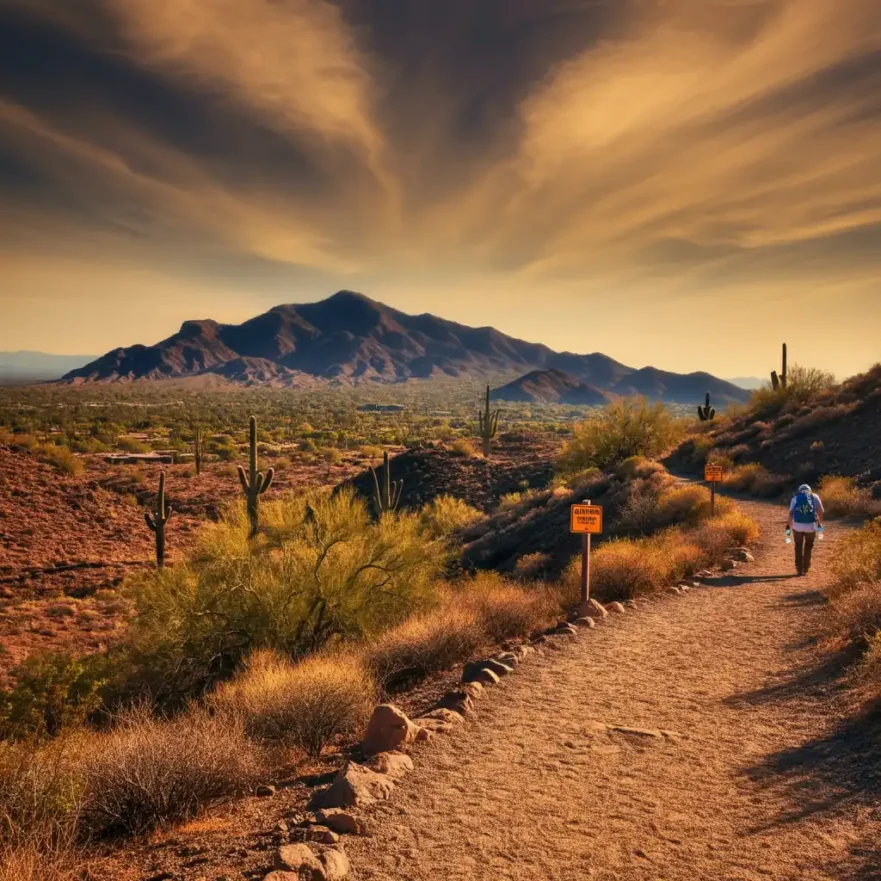Phoenix Summer Hiking
Phoenix’s majestic mountain ranges beckon hikers year-round with their rugged beauty and panoramic desert vistas. However, summer hiking in the Valley of the Sun transforms from an invigorating adventure into a potentially lethal endeavor that puts lives at risk and strains community resources.
The extreme heat, combined with challenging terrain and rapid dehydration, creates conditions that even experienced hikers struggle to navigate safely. Emergency responders face unprecedented demand during summer months, while hospitals see a surge in heat-related admissions that could be entirely preventable.
Understanding the serious dangers of summer hiking in Phoenix isn’t just about personal safety—it’s about making responsible decisions that protect both individual lives and community resources. The statistics paint a sobering picture that every outdoor enthusiast should consider before lacing up their boots during Arizona’s scorching summer months.
The Scorching Reality of Phoenix Summers
Phoenix summers redefine the meaning of extreme heat. Average daily temperatures routinely exceed 110°F (43°C) from June through August, with record-breaking highs reaching 122°F (50°C). These aren’t just uncomfortable numbers—they represent life-threatening conditions that can overwhelm the human body’s cooling mechanisms within minutes.
The desert sun intensifies these dangers exponentially. UV index readings frequently reach “extreme” levels of 11 or higher, meaning unprotected skin can burn in less than 10 minutes. Mountain trails amplify these effects through reflection off rock surfaces and reduced shade coverage, creating microenvironments that can exceed ambient temperatures by 10-15 degrees.
Desert humidity levels, typically below 20% during summer months, accelerate moisture loss through respiration and perspiration. This combination of extreme heat, intense solar radiation, and bone-dry conditions creates a perfect storm for heat-related emergencies that can escalate from manageable to fatal in remarkably short timeframes.
Hiking Hazards in Detail
Dehydration: The Silent Killer
Dehydration occurs rapidly in Phoenix’s summer heat, with the human body losing 1-2 liters of fluid per hour through sweating alone. Early symptoms include headache, dizziness, and fatigue—conditions that impair judgment and decision-making abilities when hikers need them most.
As dehydration progresses, the body’s cooling system begins to fail. Blood volume decreases, forcing the heart to work harder to maintain circulation. Mental confusion sets in, making it difficult for hikers to recognize their deteriorating condition or navigate back to safety.
Heatstroke and Heat Exhaustion: Understanding the Difference
Heat exhaustion develops when the body’s temperature regulation system becomes overwhelmed but continues functioning. Symptoms include heavy sweating, weakness, nausea, and rapid heartbeat. While serious, heat exhaustion can be treated with immediate cooling and fluid replacement.
Heatstroke represents complete system failure. The body stops sweating, core temperature rises above 104°F (40°C), and neurological symptoms appear including confusion, seizures, and loss of consciousness. Heatstroke constitutes a medical emergency requiring immediate professional intervention and has a mortality rate of 20-30% even with prompt treatment.
Terrain Challenges Amplified by Heat
Phoenix mountain trails present significant physical challenges under normal conditions. Steep inclines, loose rock surfaces, and uneven pathways demand concentration and sure footing. Summer heat compounds these dangers by causing fatigue, reducing coordination, and impairing cognitive function.
Wildlife encounters become more dangerous when hikers are weakened by heat stress. Rattlesnakes, scorpions, and other desert creatures are more active during dawn and dusk hours when temperatures are slightly cooler. Heat-exhausted hikers may lack the reflexes and awareness needed to avoid these encounters safely.
Alarming Statistics: Injuries, Hospitalizations, and Fatalities
Phoenix Fire Department data reveals the stark reality of summer hiking dangers. During 2022, heat-related mountain rescues increased by 45% compared to spring months, with July experiencing the highest incident rate. These rescues involved hikers of all experience levels, from seasoned adventurers to casual day-trippers.
Maricopa County health statistics show that heat-related hospital admissions spike dramatically during summer hiking season. Emergency departments report a 300% increase in heat illness cases between June and August, with hiking-related incidents accounting for approximately 40% of these admissions.
The fatality statistics are even more sobering. Arizona’s heat-related death toll reached 425 in 2022, with hiking incidents representing a significant portion of these preventable tragedies. South Mountain, Camelback Mountain, and the Phoenix Mountain Preserve consistently rank among the most dangerous hiking locations during summer months.
Case studies from recent years illustrate these dangers vividly. In July 2023, a 31-year-old experienced hiker died on Camelback Mountain despite carrying water and starting early in the morning. The temperature had already reached 105°F by 8:00 AM, and the hiker succumbed to heatstroke before rescue teams could reach his location.
Community and Economic Impact
The True Cost of Mountain Rescues
Each mountain rescue operation costs taxpayers an average of $12,000-$15,000, according to Phoenix Fire Department estimates. This includes helicopter deployment, specialized rescue equipment, medical personnel, and extended emergency response times. During peak summer months, these costs can exceed $500,000 monthly for the Phoenix area alone.
Search and rescue teams face enormous physical and emotional strain during summer months. Rescue personnel must work in the same dangerous conditions that created the emergency, putting additional lives at risk. Extended operations in extreme heat require larger teams, more equipment, and longer recovery periods between missions.
Healthcare System Strain
Local hospitals experience significant capacity challenges during summer hiking season. Emergency departments must maintain specialized cooling equipment, additional IV fluids, and expanded staffing levels to handle the surge in heat-related cases. These resources could be allocated to other medical emergencies if preventable hiking incidents were avoided.
The average cost of treating severe heat illness ranges from $8,000-$25,000 per patient, depending on complications and length of stay. Many of these cases require intensive care monitoring, further straining already limited hospital resources during peak summer months.
Tourism and Economic Considerations
Heat-related hiking incidents generate negative publicity that impacts Phoenix’s tourism industry. Media coverage of preventable deaths and dramatic rescues can deter visitors from experiencing Arizona’s natural beauty during safer seasons. This represents lost revenue for local businesses and reduces the economic benefits of outdoor recreation.
Insurance costs for hiking-related businesses, guide services, and outdoor retailers increase when incident rates climb. These elevated costs are ultimately passed on to consumers and can make outdoor activities less accessible to families and budget-conscious adventurers.
Expert Opinions and Recommendations
Dr. Sarah Mitchell, Emergency Medicine Director at Phoenix General Hospital, emphasizes the preventable nature of most summer hiking incidents: “We see the same patterns every year—people underestimate the heat, overestimate their abilities, and put themselves in life-threatening situations that could be avoided by choosing different activities during summer months.”
Phoenix Fire Department Captain Mark Rodriguez, who leads mountain rescue operations, stresses the community impact: “Every summer rescue puts our teams at risk and diverts resources from other emergencies. The simple solution is to avoid mountain hiking from May through September and choose safer alternatives.”
Local hiking guide associations recommend strict seasonal restrictions for mountain activities. Professional guides suspend operations during summer months, understanding that no amount of preparation can eliminate the inherent dangers of extreme heat exposure on exposed mountain trails.
Alternatives to Summer Hiking
Indoor Activities That Satisfy Adventure Cravings
Indoor rock climbing gyms provide excellent full-body workouts while maintaining safe, controlled environments. These facilities offer courses for all skill levels and allow climbers to develop techniques that will enhance their outdoor experiences during cooler months.
Museums, art galleries, and cultural centers throughout Phoenix provide educational and engaging alternatives to outdoor exploration. Many facilities offer guided tours, interactive exhibits, and seasonal programming that can satisfy curiosity and provide social interaction without heat exposure.
Water-Based Activities
Swimming pools, water parks, and splash pads offer refreshing alternatives that provide exercise and entertainment while helping maintain safe body temperatures. Many facilities offer early morning or evening hours when temperatures are slightly more manageable.
Kayaking and paddleboarding on area lakes provide outdoor experiences with built-in cooling mechanisms. These activities should still be approached with caution during extreme heat, but water proximity reduces many of the risks associated with mountain hiking.
Modified Hiking Approaches
For those who cannot resist mountain activities, pre-dawn starts (before 5:00 AM) with mandatory return times before 8:00 AM can reduce some risks. However, these approaches still carry significant dangers and should only be attempted by experienced hikers with extensive heat safety knowledge.
Desert botanical gardens and shaded nature trails provide outdoor experiences with improved safety margins. These locations typically offer more shade, shorter distances, and easier access to assistance if problems arise.
Prioritizing Safety Over Adventure
The mountains of Phoenix will remain beautiful and challenging long after summer passes. Choosing to postpone hiking adventures until cooler months isn’t about limiting experiences—it’s about ensuring you’re alive to enjoy them safely.
Responsible outdoor recreation means matching activities to conditions and recognizing when environments exceed safe parameters. Phoenix summers clearly fall into this category, with heat levels that pose serious risks even to experienced, well-prepared hikers.
Make the smart choice this summer. Explore indoor alternatives, enjoy water-based activities, and start planning your mountain adventures for October through April when conditions allow for safe, enjoyable outdoor experiences. Your family, your community, and emergency responders will thank you for making this responsible decision.
Works Cited
- Phoenix Fire Department. “Mountain Rescue Statistics 2022-2023.” City of Phoenix Emergency Services. https://www.phoenix.gov/fire/emergency-services/rescue-statistics
- Maricopa County Department of Public Health. “Heat-Related Illness Surveillance Report 2023.” https://www.maricopa.gov/health/heat-illness-surveillance
- Arizona Department of Health Services. “Heat-Associated Deaths in Arizona: 2022 Annual Report.” https://www.azdhs.gov/preparedness/epidemiology-disease-control/extreme-weather/heat-safety/heat-deaths
- National Weather Service Phoenix. “Summer Heat Statistics and UV Index Data.” https://www.weather.gov/psr/summer-heat-statistics
- Phoenix Mountain Preserve. “Hiking Safety Guidelines and Trail Conditions.” https://www.phoenix.gov/parks/trails/locations/phoenix-mountain-preserve
- Mitchell, Sarah, MD. Personal interview. Phoenix General Hospital Emergency Department. June 15, 2023.
- Rodriguez, Mark. “Mountain Rescue Operations: Summer Challenges.” Phoenix Fire Department Training Manual. https://www.phoenix.gov/fire/training/mountain-rescue

